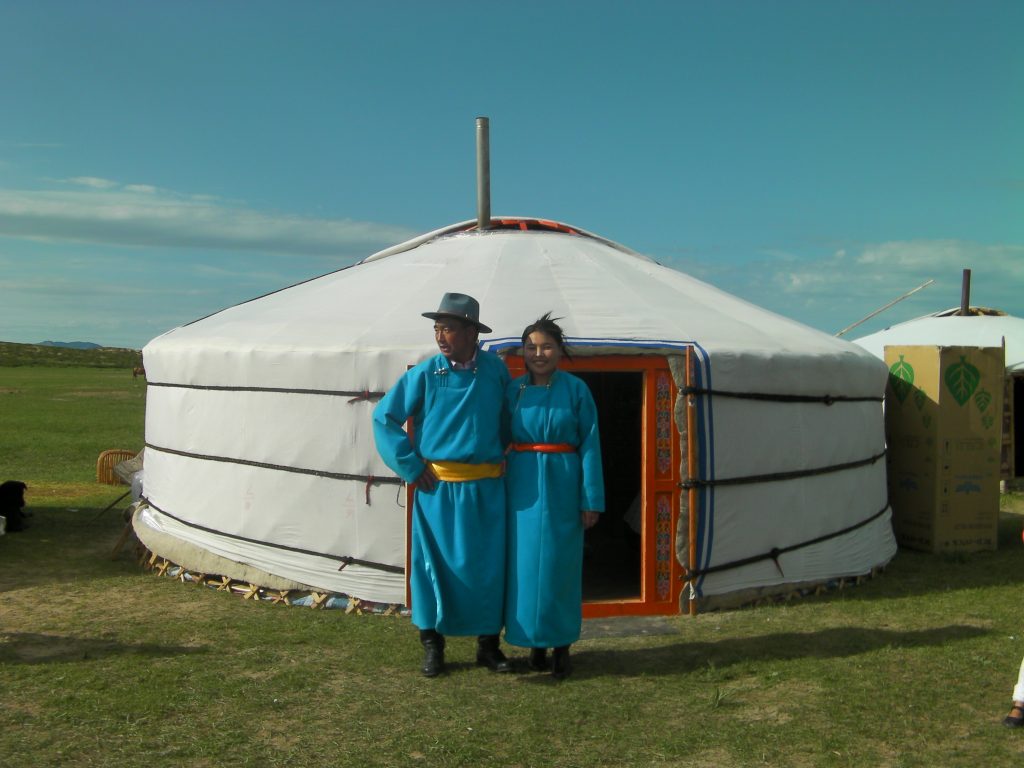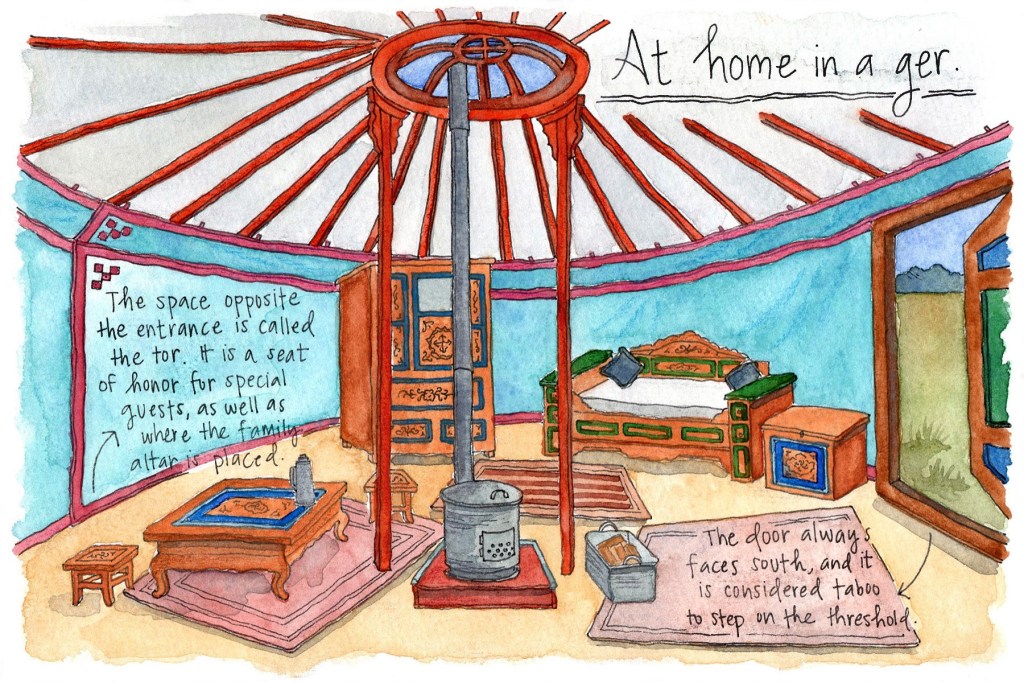“For nomads, very simply, there exists the everyday necessity of living in harmony with nature, otherwise they can’t survive – and this situation never changes”
– WHERE HORSES FLY LIKE THE WIND, Silk Road film series.


Ideally designed for extreme climates, the Mongolian Yurt has all the qualities required for the nomadic pastoral life: light, quick to assemble, and perfect insulation against the cold and harsh weathers. On top of that, it is also a highly symbolic place to live: a space where men and gods meet. There must be a reason why about 50% of the population still live in them. Read on further to grasp a little about this humble yet critical habitat of the nomads.
What makes a Ger?
On Mongolian lands, where the thermal amplitude is considerably huge, between -35°C degrees in winter and sometimes 40°C degrees in summer, the accurate choice of materials to keep warm/cool is of paramount importance.
The majority of Mongolian landscapes are bare lands, thus large wood is rather rare, and it was necessary for nomads to conceive a light, transportable architecture. Therefore, long sturdy branches were used for the skeleton of the Yurt, rather than heavy beams.

With an ingenious design, the Ger consists of several wooden lattice woven to become the wall on top of the floor, and connects to the door. In the center of the construction the roof or crown is placed on two columns, then a bundle of straight wood is put between the crown and wall, which gives the ger its frame. After the assembly is done, all that remains is to cover it.
As for the covers, nomads used what they could obtain best – felt – the wool of the herd. On the frame, two long covers of felt is unfolded on top of and around the ger; one or more layers depending on the season. The crown is also covered by a separate, smaller cover, which is used to fold open to let light in and close shut during rain or snow. At the end, everything is then kept in place with tightened ropes around the yurt. During summers, the bottom of the wall covers are often flipped up to let wind in, so a yurt is never too hot.
It’s truly a versatile home!
The Four Cardinal Directions

Always facing to the South, people enter the Ger through a wooden door, painted and decorated with sacred motifs, often with an orange background and blue geometry. Once inside, the room can be seen neatly organized around the fireplace in the center. For Mongolians, fire is one of the sacred elements and is considered a link between earth and sky, thus deeply respected. To keep the fire separate from the ground, traditionally, three stones are placed on the bottom of the stove.
The East side, under the protection of the sun, is the side of the wife, women and children. This side is where the family belongings are located: the kitchen and utensils are put closer to the door, then further in the parents bed is located, at the foot of which the children sleep.
The West side, protected by the sky, is the side of man or head of house. Here’s where the saddle and bridles of horses are stored. This is where the head of family usually sits, while observing the outside and the herds straight through the door.
Finally, facing the door, the North side is considered a place of sacred space. Here, the altars to the gods, pictures of ancestors, precious items, official awards, musical instruments and weapons are placed. It can also be the place of honor where the guest will sit, slightly shifted to the west.
The Legend & Belief in a Ger

According to a legend from the Mongolian Secret History, the mother of the Mongol people, a widowed Alungoo was living in a yurt with her two sons, when an angel from the sky came in through the crown, and gifted three sons to her. These 5 sons then continued the Golden Lineage in the Mongol people, from which the famous Chinggis Khaan was born out of.
The Mongols have always considered yurts as the sacred link between heaven, earth and their ancestors. Through the opening on the roof, the vastness of the Tengri, “sky and cosmos” in mongolian, and the force of the sky penetrates. And the sacred earth on which a yurt sits, gives the people stability and life.
Rules to respect
There are many traditions and customs nomads have with living in a ger. It is said that Chinggis Khaan himself ordered the rules of how to approach or behave within yurts.

Among these rules, remember that:
- One should never knock before entering and absolutely avoid touching the door frame, either with your head or by stepping on it.
- Once inside, avoid leaning on a wall, column or a piece of furniture, as it might collapse the yurt;
- Never turn your back North to the altar, as it’s very offensive to the gods and ancestors;
- Do not throw something into the fire. As it’s considered sacred, it would be a serious insult to the inhabitants, and to the gods;
- If food and drink is offered, always take with both hands or with your right hand only, and your left hand supporting the right elbow;
- Finally, if you are moving inside the yurt, always go around clockwise, unless you want to anger the gods for both yourself and the family.
We hope we gave you at least a small bit of information about mongolian gers.
There are many types of yurts in Mongolia for you to enjoy: from real nomad family yurts to yurt camps, and to geolodges! If you want to stay in any one or all of them, check out from our trips and decide what you want!
Disclaimer: Photo credits to rightful owners. Amazing yurt illustrations by Candace Rose Rardon








